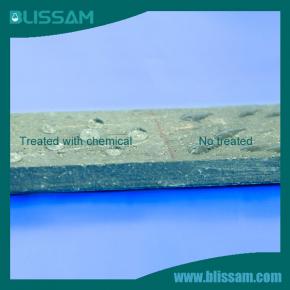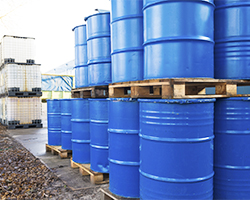ZHEJIANG BLISSAM CHEMICAL CO., LTD. have gained a strong reputation for our innovative solutions and exceptional customer service. Our mission is to provide our clients with top-of-the-line silicone fluid products that enhance their manufacturing processes and improve their overall product performance. Backed by a team of dedicated professionals and state-of-the-art facilities, we are committed to delivering excellence and exceeding customer expectations.
Silicone Fluids offers a wide range of high-performance silicone fluid products for various applications. Our portfolio includes silicone oils, emulsions, gels, and greases, all of which are compatible with a variety of materials and formulas. Our products are designed to provide superior lubrication, heat resistance, water repellency, and dielectric properties, making them ideal for use in various industries such as automotive, cosmetics, healthcare, and electronics.
Our silicone oils are available in different viscosities and can be used as base fluids or blending agents for other formulations. Our silicone emulsions are water-based and can be easily incorporated into lotions, creams, and other personal care products. We also offer silicone gels, which are known for their excellent thermal stability and cushioning properties, making them suitable for use in medical devices and sports equipment. Our silicone greases are ideal for lubricating various mechanical parts and are highly resistant to extreme temperatures and chemical exposure.
At Silicone Fluids, we understand the importance of product quality, which is why we follow strict manufacturing standards and conduct thorough quality control tests to ensure that all our products meet industry standards and customer specifications. Our commitment to innovation and customer satisfaction has made us a trusted partner for many companies around the world.
Silicone Fluids are versatile and highly functional products that have taken the market by storm. These silicone-based compounds offer superior resilience, excellent lubrication, and an impressive temperature range, making them suitable for a wide range of applications. Whether used in industrial settings, personal care products, or as a sealant, Silicone Fluids offer exceptional performance and durability. With their unique properties, they offer unmatched protection against moisture, heat, and chemical corrosion. These premium products provide a high-quality solution for all your fluid needs. Choose Silicone Fluids for reliable and long-lasting performance in any environment.

Silicone fluids, also known as silicone oils, are a type of synthetic polymer fluid that is commonly used in various industries due to its unique properties. These fluids are composed mainly of silicon atoms and oxygen atoms, giving them a characteristic flexibility and heat resistance. They are available in a wide range of viscosities, making them suitable for a variety of applications including lubrication, release agents, and coatings. With their low surface tension and non-toxic nature, silicone fluids are also commonly used in the cosmetic and personal care industry. In addition, they are highly stable and have excellent electrical insulation properties, making them suitable for use in electronic devices. Overall, silicone fluids offer a versatile and efficient solution for many different industries and applications.
1.What is the role of silicone fluids in the production of adhesives and sealants?
2.Can silicone fluids be used as a substitute for mineral oils in industrial applications?
3.What techniques are used to analyze and measure the different physical and chemical properties of silicone fluids?
4.Can silicone fluids be mixed with other chemicals and substances, and what are the potential consequences of such mixtures?
5.How do silicone fluids interact with different types of surfaces and materials?
6.What is the relationship between silicone fluids and water repellency?
7.What are the different uses of silicone fluids in the food and beverage industry?
8.What are the potential health effects of exposure to silicone fluids?
1.What is the role of silicone fluids in the production of adhesives and sealants?
Silicone fluids, also known as silicone oils, play a crucial role in the production of adhesives and sealants. They are used as additives to modify the properties of the final product, such as viscosity, adhesion, and flexibility. Some of the specific roles of silicone fluids in the production of adhesives and sealants include: 1. Lubrication: Silicone fluids act as lubricants in the production process, making it easier to mix and process the ingredients. They also reduce friction and prevent the adhesives and sealants from sticking to the production equipment. 2. Viscosity control: Silicone fluids are available in a wide range of viscosities, from low to high. This allows manufacturers to adjust the viscosity of their adhesives and sealants to meet specific application requirements. 3. Enhancing adhesion: Silicone fluids can improve the adhesion of adhesives and sealants to various substrates, including metals, plastics, and glass. They also help to reduce the surface tension of the adhesive, allowing it to spread evenly and form a strong bond. 4. Flexibility and durability: Silicone fluids can improve the flexibility and durability of adhesives and sealants, making them more resistant to temperature changes, weathering, and chemical exposure. 5. Water resistance: Silicone fluids are hydrophobic, meaning they repel water. This property makes them ideal for use in adhesives and sealants that need to withstand exposure to moisture or water. 6. Thermal stability: Silicone fluids have a high thermal stability, meaning they can withstand high temperatures without breaking down. This makes them suitable for use in adhesives and sealants that will be exposed to heat or used in high-temperature applications. 7. UV resistance: Some silicone fluids have UV-resistant properties, making them suitable for use in adhesives and sealants that will be exposed to sunlight or other sources of UV radiation. Overall, silicone fluids play a critical role in improving the performance and properties of adhesives and sealants, making them more versatile and suitable for a wide range of applications.
2.Can silicone fluids be used as a substitute for mineral oils in industrial applications?
Yes, silicone fluids can be used as a substitute for mineral oils in industrial applications. Silicone fluids have several advantages over mineral oils, including higher thermal stability, better oxidation resistance, and lower volatility. They also have a wider temperature range and are less likely to form deposits or sludge. However, silicone fluids may not be suitable for all industrial applications, so it is important to consult with a specialist to determine the best fluid for a specific application.
3.What techniques are used to analyze and measure the different physical and chemical properties of silicone fluids?
1. Viscosity Measurement: Viscosity is a key physical property of silicone fluids that can be measured using various techniques such as rotational viscometry, capillary viscometry, and falling ball viscometry. 2. Density Measurement: The density of silicone fluids can be measured using techniques such as pycnometer method, hydrostatic weighing, and gas pycnometry. 3. Refractive Index Measurement: Refractive index is an important optical property of silicone fluids that can be measured using techniques such as Abbe refractometry, refractometry, and ellipsometry. 4. Thermal Analysis: Thermal properties of silicone fluids such as melting point, glass transition temperature, and thermal stability can be analyzed using techniques such as differential scanning calorimetry (DSC), thermogravimetric analysis (TGA), and thermal conductivity measurement. 5. Spectroscopic Analysis: Infrared (IR) and nuclear magnetic resonance (NMR) spectroscopy are commonly used techniques to analyze the chemical structure and composition of silicone fluids. 6. Gas Chromatography (GC): GC is a powerful analytical technique used to separate and identify the individual components of a silicone fluid mixture. 7. Mass Spectrometry (MS): MS is a highly sensitive technique that can be used to determine the molecular weight and structure of silicone fluids. 8. Surface Tension Measurement: Surface tension is an important physical property of silicone fluids that can be measured using techniques such as pendant drop method, Wilhelmy plate method, and du Nouy ring method. 9. Rheological Analysis: Rheological properties of silicone fluids, such as shear stress and shear rate, can be measured using techniques such as rotational rheometry and oscillatory rheometry. 10. Particle Size Analysis: Particle size distribution of silicone fluids can be determined using techniques such as laser diffraction, dynamic light scattering, and sedimentation analysis.
4.Can silicone fluids be mixed with other chemicals and substances, and what are the potential consequences of such mixtures?
Silicone fluids can be mixed with other chemicals and substances, but it is important to consider the potential consequences of such mixtures. Some potential consequences include: 1. Incompatibility: Silicone fluids may not be compatible with certain chemicals and substances, leading to separation or precipitation of the mixture. This can result in reduced effectiveness or even complete failure of the intended application. 2. Changes in properties: Mixing silicone fluids with other chemicals and substances can alter their physical and chemical properties, such as viscosity, surface tension, and thermal stability. This can affect their performance and may lead to unexpected results. 3. Chemical reactions: Some chemicals and substances may react with silicone fluids, resulting in the formation of new compounds that can be harmful or toxic. This can pose a risk to human health and the environment. 4. Reduced effectiveness: Mixing silicone fluids with other chemicals and substances may dilute their concentration and reduce their effectiveness. This can result in the need for higher dosages or more frequent applications, leading to increased costs. 5. Safety hazards: Certain mixtures of silicone fluids with other chemicals and substances can pose safety hazards, such as flammability or corrosiveness. It is important to carefully assess the potential risks before mixing these substances. Overall, it is important to carefully consider the potential consequences and risks before mixing silicone fluids with other chemicals and substances. It is recommended to consult with a professional or conduct thorough testing before using any mixtures in industrial or commercial applications.
5.How do silicone fluids interact with different types of surfaces and materials?
Silicone fluids, also known as silicone oils, are synthetic polymers that are widely used in various industries due to their unique properties such as high thermal stability, low surface tension, and water repellency. These fluids can interact with different types of surfaces and materials in various ways, depending on their chemical composition and the properties of the surface or material. 1. Metals: Silicone fluids have a low surface tension, which allows them to spread easily on metal surfaces. They can also form a thin, uniform film on the surface, providing excellent lubrication and protection against corrosion. However, some metals, such as aluminum, can react with silicone fluids and cause surface damage. 2. Plastics: Silicone fluids have a low surface tension and can easily wet plastic surfaces. They can also improve the surface gloss and reduce the coefficient of friction of plastic materials. However, some plastics, such as polycarbonate, can be affected by silicone fluids and may become brittle or discolored. 3. Rubber: Silicone fluids have good compatibility with rubber materials and can improve their flexibility and durability. They can also act as a release agent, preventing rubber from sticking to molds or other surfaces. However, some types of silicone fluids can cause swelling or softening of certain rubber materials. 4. Glass: Silicone fluids have a high refractive index, making them suitable for use as a lubricant or coating on glass surfaces. They can also improve the optical clarity and scratch resistance of glass. However, some types of silicone fluids can cause fogging or hazing on glass surfaces. 5. Fabrics: Silicone fluids can be used as a fabric softener, providing a smooth and soft feel to fabrics. They can also improve the water repellency and stain resistance of fabrics. However, some fabrics, such as nylon, can be affected by silicone fluids and may lose their strength and elasticity. 6. Paper: Silicone fluids can be used as a paper coating, providing a glossy and water-resistant surface. They can also improve the printability and reduce the static charge of paper. However, some types of silicone fluids can cause ink smudging or paper curling. In general, silicone fluids have good compatibility with most surfaces and materials, but it is important to consider the specific properties and potential interactions before using them. It is also recommended to conduct compatibility tests before using silicone fluids on a large scale.

6.What is the relationship between silicone fluids and water repellency?
Silicone fluids are commonly used as water repellents due to their hydrophobic nature. This means that they have a low affinity for water and tend to repel it. When applied to a surface, silicone fluids create a thin, water-resistant layer that prevents water from penetrating or being absorbed. This makes them effective in protecting surfaces from water damage, such as in waterproof coatings for fabrics or sealants for buildings. Additionally, silicone fluids have a high surface tension, which allows them to form droplets on surfaces, further enhancing their water repellent properties. Overall, the relationship between silicone fluids and water repellency is that silicone fluids are often used as water repellents due to their hydrophobic nature and ability to form a protective barrier against water.
7.What are the different uses of silicone fluids in the food and beverage industry?
1. Lubricant: Silicone fluids are commonly used as lubricants in food processing equipment such as mixers, conveyors, and packaging machines. They provide smooth and consistent movement of parts, reducing friction and wear. 2. Release agent: Silicone fluids are also used as release agents in food molds and baking trays. They prevent food from sticking to the surface, making it easier to remove and reducing waste. 3. Antifoaming agent: In the production of beverages such as beer, wine, and soft drinks, silicone fluids are used as antifoaming agents. They prevent excessive foaming during fermentation and bottling processes. 4. Moisturizer: Silicone fluids are added to food products such as baked goods, confectionery, and sauces to improve texture and prevent them from drying out. They also help to maintain the freshness and shelf life of these products. 5. Defoamer: In the production of edible oils and fats, silicone fluids are used as defoamers to remove excess foam that can occur during processing. 6. Glazing agent: Silicone fluids are used as glazing agents in the production of fruits and vegetables. They provide a shiny and glossy appearance, making the produce more visually appealing. 7. Flavor carrier: Some silicone fluids are approved for use as flavor carriers in food products. They help to evenly distribute flavors and enhance the taste of the final product. 8. Packaging material: Silicone fluids are used in the production of food packaging materials such as films and coatings. They provide a barrier against moisture, oxygen, and other contaminants, helping to preserve the quality and freshness of the food. 9. Food-grade lubricant: In food processing facilities, silicone fluids are used as lubricants for conveyor belts, chains, and other equipment that come in contact with food. They are safe for use in food environments and do not contaminate the food. 10. Food-grade sealant: Silicone fluids are used as sealants for food packaging containers, ensuring a tight and secure seal to prevent leakage and contamination.
8.What are the potential health effects of exposure to silicone fluids?
1. Skin Irritation: Exposure to silicone fluids can cause skin irritation, redness, and itching. Prolonged or repeated contact with the skin can lead to dermatitis. 2. Eye Irritation: Silicone fluids can cause irritation and redness if they come into contact with the eyes. In severe cases, it can also cause corneal damage. 3. Respiratory Problems: Inhaling silicone fluids can irritate the respiratory tract and cause coughing, wheezing, and difficulty breathing. Prolonged exposure can lead to chronic respiratory problems. 4. Allergic Reactions: Some people may develop an allergic reaction to silicone fluids, which can cause symptoms such as hives, swelling, and difficulty breathing. 5. Neurotoxicity: There is some evidence that long-term exposure to silicone fluids may have neurotoxic effects, leading to symptoms such as headaches, dizziness, and memory problems. 6. Reproductive and Developmental Effects: Animal studies have shown that exposure to silicone fluids may have adverse effects on reproductive and developmental health. However, more research is needed to determine the potential effects on humans. 7. Environmental Impact: Silicone fluids are not easily biodegradable and can persist in the environment for a long time. They can also be toxic to aquatic life and may bioaccumulate in the food chain. 8. Silicone Implant Complications: Silicone fluids are commonly used in breast implants, and there have been reports of complications such as implant rupture, leakage, and migration of silicone into the body. 9. Cancer Risk: There is limited evidence to suggest that silicone fluids may increase the risk of certain types of cancer, such as breast cancer. However, more research is needed to establish a clear link. 10. Other Health Effects: Some studies have linked exposure to silicone fluids with other health issues, such as immune system dysfunction, endocrine disruption, and liver damage. However, more research is needed to confirm these findings.
Contact:
Phone: +86-15957191858
E-mail: info@blissam.com
Whatsapp:+8615957191858
Add: A647, No. 9, Xiyuan Road, Xihu District, Hangzhou, Zhejiang, China
We chat
